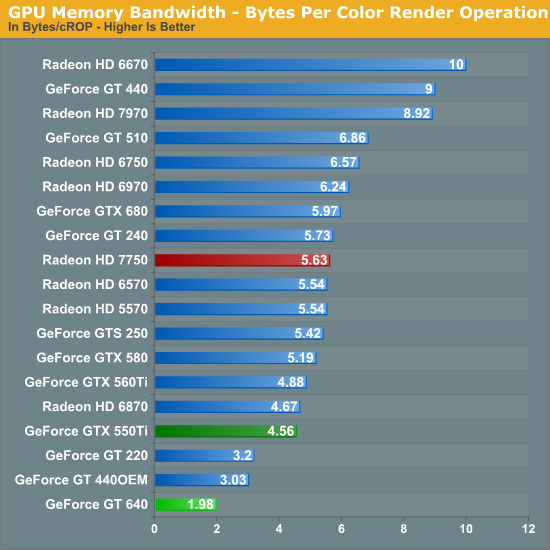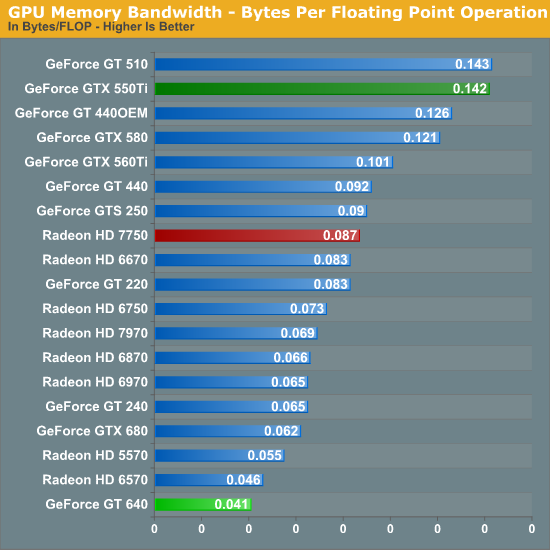Zotac GeForce GT 640 DDR3 Review: Glacial Gaming & Heavenly HTPC
by Ryan Smith & Ganesh T S on June 20, 2012 12:00 PM ESTMusing About Memory Bandwidth & The Test
As we discussed in our introduction, NVIDIA is launching the GeForce GT 640 exclusively as a DDR3 part. Because of the lack of memory bandwidth this is going to hold back the performance of the card, and while we don’t have a GDDR5 card at this time it will still be pretty easy to see what the performance impact is once we jump into our gaming performance section and compare it to other cards like the GTS 450.
In the meantime however we wanted to try to better visualize just how little memory bandwidth the DDR3 GT 640 had. It’s one thing to say that the card has 28GB/sec of memory bandwidth, but how does that compare to other cards? For the answer to that we drew up a couple of graphs based on the ratio of theoretical memory bandwidth to theoretical performance.

The first graph is the ratio of memory bandwidth to color pixel ROPs (bytes per color operation), which is an entirely synthetic metric but a great illustration of the importance of memory bandwidth. Render operations are the biggest consumer of memory bandwidth so this is where DDR3 cards typically choke.
Because of the nature of this graph cards are all over the place, with cards with particularly unusual configurations (such as the 4 ROP GT 440) appearing near the top. Still, high-end cards such as the GTX 680 and Radeon HD 7970 have among the highest ratio of memory bandwidth to color render operations, while lower-end cards generally have a lower ratio. At 1.97 B/cOP, the DDR3 GT 640 has the lowest ratio by far, and is only 66% of the ratio found on the next-lowest card, the GeForce GT 440 OEM. The fact of the matter is that because of its high clockspeed and 16 ROPs, the DDR3 GT 640 has by far the lowest ratio than any other card before it.

Our second graph is the ratio of memory bandwidth to shader operations (bytes per FLOP). Shaders aren’t nearly as bandwidth constrained as ROPs thanks to liberal use of register files and caches, but I wanted to take a look at more than just one ratio. Compared to our ROP chart the GT 640 isn’t nearly as much of an outlier, but it still has the lowest ratio of memory bandwidth per FLOP out of all of the cards in our charts.
Now to be clear not all of this is NVIDIA’s fault. Memory speeds have not kept pace with Moore’s Law, so GPU performance has been growing faster than memory speeds for quite some time leading to a general downwards trend. But the GT 640 is a special card in this respect in that there has never been a card this starved for memory bandwidth. This is further impacted by the fact that while GDDR5 speeds have at least been increasing as a modest rate over the years as GPU memory controllers and memory chip production have improved, DDR3 memory speeds have been locked in the 1.6GHz-1.8GHz range for years. Simply put, the gap between GDDR5 and DDR3 has never been greater. Even a conservative memory clock of 4.5GHz would give a GDDR5 card 2.5 times the memory bandwidth of a typical DDR3 card.
Of course there’s still a place in the world for DDR3 cards, particularly in very low power situations, but that place is shrinking in size every day. If and when it arrives, we expect that the GDDR5 GT 640 will quickly trounce the DDR3 version in virtually all gaming scenarios. DDR3 for a card this power hungry (relatively speaking) and with this many ROPs just doesn’t look like it makes a lot of sense.
The Test
For our test we’re using the latest NVIDIA drivers at the time our benchmarks were taken (301.42), and for AMD’s cards we’re using the new Catalyst 12.6 betas. For analysis purposes we’ve thrown in a couple of additional cards that we don’t normally test, such as the GDDR5 GeForce GT 240. The GDDR5 GT 240 has 43.5GB/sec of memory bandwidth but with a far older and less powerful GPU, which makes for an interesting comparison on progress.
| CPU: | Intel Core i7-3960X @ 4.3GHz |
| Motherboard: | EVGA X79 SLI |
| Chipset Drivers: | Intel 9.2.3.1022 |
| Power Supply: | Antec True Power Quattro 1200 |
| Hard Disk: | Samsung 470 (256GB) |
| Memory: | G.Skill Ripjaws DDR3-1867 4 x 4GB (8-10-9-26) |
| Case: | Thermaltake Spedo Advance |
| Video Cards: |
AMD Radeon HD 7770 AMD Radeon HD 7750-800 AMD Radeon HD 6670 AMD Radeon HD 5750 NVIDIA GeForce GT 640 DDR3 NVIDIA GeForce GTX 550 Ti NVIDIA GeForce GTS 450 NVIDIA GeForce GT 440 NVIDIA GeForce GT 240 |
| Video Drivers: |
NVIDIA ForceWare 301.42 AMD Catalyst 12.6 Beta |
| OS: | Windows 7 Ultimate 64-bit |










60 Comments
View All Comments
Joe H - Wednesday, June 20, 2012 - link
This is the type of review that other hardware sites can't even imagine, let alone write. Thanks for putting this and the other HTPC articles together. It's great to see a hardware review site taking HTPC enthusiasts and their needs seriously. Excellent review.n0b0dykn0ws - Wednesday, June 20, 2012 - link
Is there a chance of a follow up once a few driver updates have been released?I would love to see if the card gets even better after a few releases.
I have a Radeon 6570 right now, and I've found it to be palatable for HTPC purposes.
n0b0dykn0ws
Taft12 - Wednesday, June 20, 2012 - link
They haven't done it before, I don't know why they'd start now.Ryan Smith - Thursday, June 21, 2012 - link
What specifically are you looking for? Gaming performance or HTPC functionality? Gaming performance isn't likely to improve; even with the newer architecture it's not Kepler that's the limiting factor. HTPC functionality on the other hand can easily be improved with drivers.n0b0dykn0ws - Thursday, June 21, 2012 - link
HTPC only. For gaming I would get a 670.Sometimes drivers break HTPC performance/quality though. At least in the AMD world.
n0b0dykn0ws
Kevin G - Wednesday, June 20, 2012 - link
If they're going to release a DDR3 version, why not just offer a version with no onboard memory and two DIMM slots so that users can add there own? You can get a DDR3-2133 kit which would boost bandwidth limited scenarios by roughly 15%. While I don't see the need, such a card could be upgraded all the way to 16 GB of memory.MrSpadge - Thursday, June 21, 2012 - link
Sockets- are unconventional (I don't think nVidia likes this word)
- introduce a little cost (GPU manufacturer doesn't like it)
- make the board larger (GPU manufacturer doesn't like it)
- make the bus timing worse, so it's harder to clock them as high as directly soldered chips (wouldn't matter with DDR3, though)
- introduce another point of failure (GPU manufacturer doesn't like higher RAM rates)
- add cost to the overall product, as the end user wouldn't get as sweet a deal on RAM as the GPU manufacturer (this would eat into the GPU manufacturers profit margin)
Stuka87 - Wednesday, June 20, 2012 - link
Sounds like unless temps are really important to you, the 7750-800 is by far the better choice. It outperforms the GT640 (And by a wide margin in some cases) in what looks like, every single test.And they are priced the same, which makes the GT640 kind of worthless for its intended price point.
cjs150 - Wednesday, June 20, 2012 - link
Great review.It is too noisy, and the HDMI socket is an epic design fail. As a card for an HTPC what were Zotac thinking of? This is so badly wrong.
Now onto frame rates. Nvidia, AMD and Intel really are total and utter idiots or they have decided that we the customers are total and utter idiots. There is simply no excuse for all IGPs and video cards not to be able to lock on to the correct frame rate with absolute precision. It is not as though the frame rate specs for film have changed recently. I cannot decide whether it is sloppiness, arrogance or they simply do not give a rats a##e for the customer experience.
Stuka87 - Wednesday, June 20, 2012 - link
God forbid there be a technical reason for it....